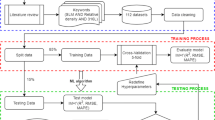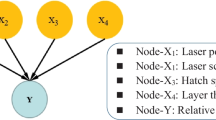Abstract
Additive manufacturing process is widely adopted for the development of near net shape components of complex geometries that are used in aerospace, automobiles, and medical industries. However, the variables like alloy types, process parameters, printing method, and printer types govern the defects formation, microstructure evolution, and mechanical properties of the component during service conditions. In this work, multiple machine learning models have been implemented to predict the densification of Al-50 Si alloy for the given input parameters. Three hundred and fifty samples have been printed by selective laser melting route for different power, scan speed, and hatch distance and their densification has been measured using Archimede’s principle. Random forest, decision tree, and neural network-based algorithms have been used to predict the densification. The decision tree model exhibited R2 value of 93.16% and outperformed the random forest model. Neural network model has predicted the densification with a minimum mean square error of 1.1994×10−04 for 500 iterations. The random forest model is implemented to identify the importance of process parameters on the densification and it is also observed that the scan speed is the most significant and hatch distance is the least significant parameter. The three models are experimentally validated and neural network-based model is able to predict densification with accuracy.








Similar content being viewed by others
Reference
H.S. Dai and X.F. Liu, Refinement Performance and Mechanism of an Al-50Si Alloy, Mater. Charact., 2008, 59(11), p 1559–1563.
Z. Cai, C. Zhang, R. Wang, C. Peng, X. Wu and H. Li, High-Temperature Mechanical Properties and Thermal Cycling Stability of Al-50Si Alloy for Electronic Packaging, Mater. Sci. Eng. A, 2018, 728, p 95–101.
F. Cao, Y. Jia, K.G. Prashanth, P. Ma, J. Liu, S. Scudino, F. Huang, J. Eckert and J. Sun, Evolution of Microstructure and Mechanical Properties of As-Cast Al-50Si Alloy Due to Heat Treatment and P Modifier Content, Mater. Des., 2015, 74, p 150–156.
Y. Jia, F. Cao, S. Scudino, P. Ma, H. Li, L. Yu, J. Eckert and J. Sun, Microstructure and Thermal Expansion Behavior of Spray-Deposited Al-50Si, Mater. Des., 2014, 57, p 585–591.
V. Romanova, O. Zinovieva, R. Balokhonov, E. Dymnich, E. Moskvichev, A. Filippov and D. Lychagin, Effects of the Grain Shape and Crystallographic Texture on the Grain-Scale Mechanical Behavior of Additively Manufactured Aluminum Alloys, Addit. Manuf., 2021, 48, p 102415. https://doi.org/10.1016/j.addma.2021.102415
E. Louvis, P. Fox and C.J. Sutcliffe, Selective Laser Melting of Aluminium Components, J. Mater. Process. Technol., 2011, 211(2), p 275–284.
N.T. Aboulkhair, M. Simonelli, L. Parry, I. Ashcroft, C. Tuck and R. Hague, 3D Printing of Aluminium Alloys: Additive Manufacturing of Aluminium Alloys Using Selective Laser Melting, Prog. Mater. Sci., 2019, 106, p 100578.
J. Zhang, B. Song, Q. Wei, D. Bourell and Y. Shi, A Review of Selective Laser Melting of Aluminum Alloys: Processing, Microstructure, Property and Developing Trends, J. Mater. Sci. Technol., 2019, 35(2), p 270–284.
S. Romano, A. Brückner-Foit, A. Brandão, J. Gumpinger, T. Ghidini and S. Beretta, Fatigue Properties of AlSi10Mg Obtained by Additive Manufacturing: Defect-Based Modelling and Prediction of Fatigue Strength, Eng. Fract. Mech., 2018, 187, p 165–189. https://doi.org/10.1016/j.engfracmech.2017.11.002
Y.N. Hu, S.C. Wu, P.J. Withers, J. Zhang, H.Y.X. Bao, Y.N. Fu and G.Z. Kang, The Effect of Manufacturing Defects on the Fatigue Life of Selective Laser Melted Ti-6Al-4V Structures, Mater. Des., 2020, 192, p 108708.
S.C. Wu, T.Q. Xiao and P.J. Withers, The Imaging of Failure in Structural Materials by Synchrotron Radiation X-Ray Microtomography, Eng. Fract. Mech., 2017, 182, p 127–156.
Z. Wu, S. Wu, J. Bao, W. Qian, S. Karabal, W. Sun and P.J. Withers, The Effect of Defect Population on the Anisotropic Fatigue Resistance of AlSi10Mg Alloy Fabricated by Laser Powder Bed Fusion, Int. J. Fatigue, 2021, 151, p 106317.
H. Shipley, D. McDonnell, M. Culleton, R. Coull, R. Lupoi, G. O’Donnell and D. Trimble, Optimisation of Process Parameters to Address Fundamental Challenges during Selective Laser Melting of Ti-6Al-4V: A Review, Int. J. Mach. Tools Manuf., 2018, 128, p 1–20.
K. Alrbaey, D. Wimpenny, R. Tosi, W. Manning and A. Moroz, On Optimization of Surface Roughness of Selective Laser Melted Stainless Steel Parts: A Statistical Study, J. Mater. Eng. Perform., 2014, 23(6), p 2139–2148.
G. Casalino, S.L. Campanelli, N. Contuzzi and A.D. Ludovico, Experimental Investigation and Statistical Optimisation of the Selective Laser Melting Process of a Maraging Steel, Opt. Laser Technol., 2015, 65, p 151–158.
F. Calignano, Design Optimization of Supports for Overhanging Structures in Aluminum and Titanium Alloys by Selective Laser Melting, Mater. Des., 2014, 64, p 203–213.
R. Mertens, S. Clijsters, K. Kempen, and J.-P. Kruth, Optimization of Scan Strategies in Selective Laser Melting of Aluminum Parts with Downfacing Areas, J. Manuf. Sci. Eng., 2014, 136(6).
M. Averyanova, E. Cicala, P. Bertrand, and D. Grevey, Experimental Design Approach to Optimize Selective Laser Melting of Martensitic 17‐4 PH Powder: Part I–Single Laser Tracks and First Layer, Rapid Prototyp. J., 2012.
M. Galetto, G. Genta, G. Maculotti and E. Verna, Defect Probability Estimation for Hardness-Optimised Parts by Selective Laser Melting, Int. J. Precis. Eng. Manuf., 2020, 21(9), p 1739–1753.
J. Sun, Y. Yang and D. Wang, Parametric Optimization of Selective Laser Melting for Forming Ti6Al4V Samples by Taguchi Method, Opt. Laser Technol., 2013, 49, p 118–124.
Z. Li, I. Kucukkoc, D.Z. Zhang, and F. Liu, Optimising the Process Parameters of Selective Laser Melting for the Fabrication of Ti6Al4V Alloy, Rapid Prototyp. J., 2018.
N. Perevoshchikova, J. Rigaud, Y. Sha, M. Heilmaier, B. Finnin, E. Labelle, and X. Wu, Optimisation of Selective Laser Melting Parameters for the Ni-Based Superalloy IN-738 LC Using Doehlert’s Design, Rapid Prototyp. J., 2017.
Y. Du, T. Mukherjee and T. DebRoy, Physics-Informed Machine Learning and Mechanistic Modeling of Additive Manufacturing to Reduce Defects, Appl. Mater. Today, 2021, 24, p 101123. https://doi.org/10.1016/j.apmt.2021.101123
T. DebRoy, T. Mukherjee, H.L. Wei, J.W. Elmer and J.O. Milewski, Metallurgy, Mechanistic Models and Machine Learning in Metal Printing, Nat. Rev. Mater., 2021, 6(1), p 48–68. https://doi.org/10.1038/s41578-020-00236-1
C. Wang, X.P. Tan, S.B. Tor, and C.S. Lim, Machine Learning in Additive Manufacturing: State-of-the-Art and Perspectives, Addit. Manuf., 2020, p 101538.
L. Meng, B. McWilliams, W. Jarosinski, H.-Y. Park, Y.-G. Jung, J. Lee and J. Zhang, Machine Learning in Additive Manufacturing: A Review, Jom, 2020, 72(6), p 2363–2377.
S. Rawat and M.-H.H. Shen, A Novel Topology Optimization Approach Using Conditional Deep Learning, arXiv prepr. arXiv:1901.04859, 2019.
I. Baturynska, O. Semeniuta and K. Martinsen, Optimization of Process Parameters for Powder Bed Fusion Additive Manufacturing by Combination of Machine Learning and Finite Element Method: A Conceptual Framework, Procedia Cirp, 2018, 67, p 227–232.
A. Caggiano, J. Zhang, V. Alfieri, F. Caiazzo, R. Gao and R. Teti, Machine Learning-Based Image Processing for on-Line Defect Recognition in Additive Manufacturing, CIRP Ann., 2019, 68(1), p 451–454.
P.C. Collins and D.G. Harlow, Probability and Statistical Modeling: Ti-6Al-4V Produced via Directed Energy Deposition, J. Mater. Eng. Perform., 2021, 30(9), p 6905–6912. https://doi.org/10.1007/s11665-021-06062-y
F. Pedregosa, G. Varoquaux, A. Gramfort, V. Michel, B. Thirion, O. Grisel, M. Blondel, P. Prettenhofer, R. Weiss and V. Dubourg, Scikit-Learn: Machine Learning in Python, J. Mach. Learn. Res., 2011, 12, p 2825–2830.
M. Korkmaz, A Study over the General Formula of Regression Sum of Squares in Multiple Linear Regression, Numer. Methods Partial Differ. Equ., 2021, 37(1), p 406–421. https://doi.org/10.1002/num.22533
Author information
Authors and Affiliations
Corresponding author
Additional information
Publisher's Note
Springer Nature remains neutral with regard to jurisdictional claims in published maps and institutional affiliations.
Rights and permissions
About this article
Cite this article
Raju, K.L., Thapliyal, S., Sigatapu, S. et al. Process Parameter Dependent Machine Learning Model for Densification Prediction of Selective Laser Melted Al-50Si Alloy and its Validation. J. of Materi Eng and Perform 31, 8451–8458 (2022). https://doi.org/10.1007/s11665-022-06831-3
Received:
Revised:
Accepted:
Published:
Issue Date:
DOI: https://doi.org/10.1007/s11665-022-06831-3




